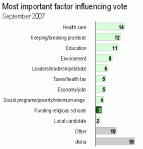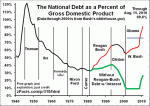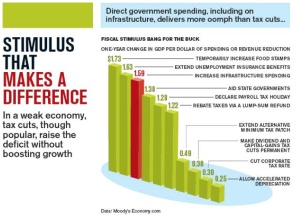 In the shadow of the elections victories of the Tea Party in the US election and the recent announcement of our own Campbell government here in BC to both cut income taxes while implementing a user fee for hospital stays, I thought it would be educational to take a sceptical look at taxes and in particular tax breaks.
In the shadow of the elections victories of the Tea Party in the US election and the recent announcement of our own Campbell government here in BC to both cut income taxes while implementing a user fee for hospital stays, I thought it would be educational to take a sceptical look at taxes and in particular tax breaks.
Taxes have been a widely used tool by governments to punish ‘sin’  (in the form of alcohol and tobacco taxes) and to promote investment (in the form of tax holidays or credits like the capital gains tax). I am not going to get too partisan here. There are valid arguments on all sides about what are appropriate taxes and at what level those taxes should be – that is a discussion for a different day and perhaps a different show. What I would like to investigate here are two things: first that cutting taxes increases tax revenue (this was called Voodoo economics by G. Bush Sr., trickle-down economics by others but economist refer to this broadly as supply-side economics) and second that tax cuts are always good.
(in the form of alcohol and tobacco taxes) and to promote investment (in the form of tax holidays or credits like the capital gains tax). I am not going to get too partisan here. There are valid arguments on all sides about what are appropriate taxes and at what level those taxes should be – that is a discussion for a different day and perhaps a different show. What I would like to investigate here are two things: first that cutting taxes increases tax revenue (this was called Voodoo economics by G. Bush Sr., trickle-down economics by others but economist refer to this broadly as supply-side economics) and second that tax cuts are always good.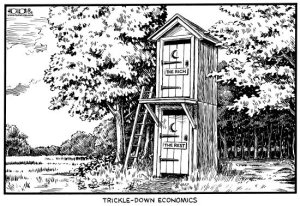
I shall address the former first. For those of us who had access to an US media source (or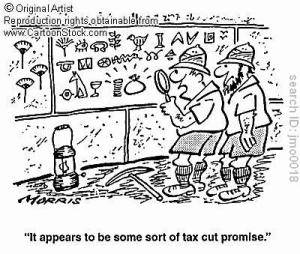 those who can remember any recent political campaign) every politician was promising to cut taxes; when asked how they would pay for these tax cuts, they would either respond by saying tax cuts cost nothing or they said they will reduce spending…when asked what spending, they would say something like “that fat in the system” or “improved efficiencies” – IE they would not cut anything. For example they often say they will cut “ear-marks’, but this only accounts for $3 billion out of a budget of $3.6+ trillion (with a deficit of $1.7 trillion)…or 0.08% of budget (0.17% of deficit).
those who can remember any recent political campaign) every politician was promising to cut taxes; when asked how they would pay for these tax cuts, they would either respond by saying tax cuts cost nothing or they said they will reduce spending…when asked what spending, they would say something like “that fat in the system” or “improved efficiencies” – IE they would not cut anything. For example they often say they will cut “ear-marks’, but this only accounts for $3 billion out of a budget of $3.6+ trillion (with a deficit of $1.7 trillion)…or 0.08% of budget (0.17% of deficit).
 It seems popular among voters across the political spectrum. However, the recent dual announcements of our local government show the reality of the situation. Campbell announces a popular across the board tax cut of 15%. This applies to rich and poor alike (although not equally, but again that’s a different show*). This equates to a loss of over half a billion dollars a year. That is money the government will not have to provide services…like hospital beds. The government also recently announced a user fee on hospital rooms amounting to over $200 a week. Who is going to make up for the loss in tax revenues? The sick.
It seems popular among voters across the political spectrum. However, the recent dual announcements of our local government show the reality of the situation. Campbell announces a popular across the board tax cut of 15%. This applies to rich and poor alike (although not equally, but again that’s a different show*). This equates to a loss of over half a billion dollars a year. That is money the government will not have to provide services…like hospital beds. The government also recently announced a user fee on hospital rooms amounting to over $200 a week. Who is going to make up for the loss in tax revenues? The sick.
Now don’t get me wrong, maybe we are all happy with that, but most people when asked the question do they want to cut public spending (especially healthcare), they say no…in fact it is one of the few areas people show an innate socialist tendency.
Just to put the two into perspective, the median family will save about $350 a year in taxes. The average hospital stay for an individual is 3-10 days (depending largely on age)…that’s a fee cost of $87 to $290 (and for those of you who say “well most people will not be in hospital that long” just remember that makes the fee even more onerous because it WILL effect most those who are suffering most and likely least like to afford it).
Okay, my math may be a little dodgy (mainly due to the lack of accurate numbers for ‘average hospital’ stay or the myriad of different income/fee/taxes an individual will pay) but the point should still be obvious. The hospital fee was not to pay for the tax cut but add in the added cost of medical insurance premiums[1], camping fees[2], transit fees[3], licence fees[4], tuition[5] and so on you will get there. (for those of us old enough, we remember when ‘user fee’ was a dirty word and the fees that did exist were token…not any more).
The point I am getting at, is if we want social services we have to pay for them as a society. That means when someone yells “tax cuts” remember they are also saying “cut services”. Maybe something you are comfortable with…maybe not but that is the reality of it. I was going to go on to talk about the wisdom of providing robust social services but that would be straying perhaps outside the bound of a sceptic podcast so we shall stop here and address the second point.
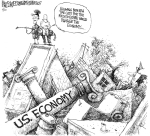 Many have claimed, largely Republicans and Monetarists, that cutting taxes increases tax revenue. On the surface this sounds paradoxical; however there is a shred of logic to be found. The idea, goes that if you cut taxes, those who have more money will invest in the economy, the economy grows, from this larger tax base you collect more absolute dollars even though the rate is lower. The idea works in reverse as well; increasing the tax rate will cause a contraction of the economy and a reduction in absolute dollars.
Many have claimed, largely Republicans and Monetarists, that cutting taxes increases tax revenue. On the surface this sounds paradoxical; however there is a shred of logic to be found. The idea, goes that if you cut taxes, those who have more money will invest in the economy, the economy grows, from this larger tax base you collect more absolute dollars even though the rate is lower. The idea works in reverse as well; increasing the tax rate will cause a contraction of the economy and a reduction in absolute dollars.
Often the example of the Reagan Revolution is used to prove this point…i.e. that it works in practice. However this is a flawed claim. As many modern economists have shown[6], including noble prize winner Paul Klugmen, the Reagan tax cuts did not improve the US economy and actually made government finances worse.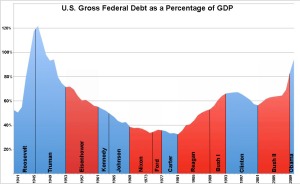
It is true the US economy grew fast from 1983-89 however this is in contrast to the miasma of the severe recession of 81-2. Capitalist markets are cyclical, and this was not an unusual recovery. Private savings, something supply-side economics assumes from the masses to provide the capital for investment, continues to decline throughout the decade (7.8->4.8%). Meaning, the money for the recovery, as it was, came from spending savings and increasing personal debt. Finally, this trend is echoed in the US budget; when Reagan came to office the US debt as a % of GDP was 32.5%, when Bush Sr. left it was 66.1%. Clinton, who raised taxes, brought the rate down to 56.4%. The same happened in Canada, when we increased taxes in the 90’s and went from the ‘basket-case’ nation to arguably the country with the most stable finances.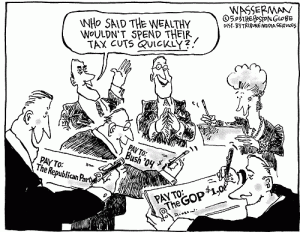
Lastly, the multiplier effect. Not all tax cuts are equal. Tax cuts cost money; those who claim that it is not should ‘not’ collect their next pay-check and see if it costs them money. So, the current desire of governments everywhere is stimulus. When the government (or anyone really) spends money it has what is called, a multiplier effect on the economy; that is for every “Y” dollars spent it generates Y*x (or Y’) in the economy. So, if I give you a dollar and you burn it, which generates no activity in the economy, in fact it removes the dollar from circulation so has a negative multiplier effect. Now most people will spend it or ‘invest’ it (be it real investments or just in your bank account) and they have a positive effect; that is they generate more than a dollars worth of economic activity. The best way to think about this is if you spend the dollar, the merchant sells more, can now hire a new employee, and we will in turn make more dollars and spend them; the new employee generates the new value. An economist could spin a better story, but I think you get the gist of it – the one dollar generates more than a dollar of economic activity.
Having given the background, how do tax cuts fair as stimulus[7]? In general, every dollar of tax cuts generates $1.30 of economic activity compared to a dollar spent on increasing UI benefits would generate $1.62 or increasing food stamps generates $1.74. There is also the issue of WHO to give the cut to. Lower income people spend (out of necessity) every penny they make so a cut in their taxes (thanks to HST we ALL pay taxes even the poorest) will generate the most activity but they latterly also have the least money (the bottom 50% of household control about 3% of Canadian wealth). As you move to the other extreme, the very wealthy often ‘invest’ most of their tax cuts (earning more than they need), so less activity generated but because they make more money a big bang (the top 10% own around 58.2% of the nation’s wealth[8] in the USA its 1% owning 35%). However, in a global world, it is most likely their investments will be ‘trans-national’ or outside ‘our’ economy and thus lost completely to the system – complete fizzle.
Society, of course, is not only extremes but a lopsided slope of ‘everything-in-between’ (note percentages of wealth ownership mentioned earlier) otherwise it would be easy to define tax policy; the trick is to determine both purpose (stimulate consumption, promote manufacturing, decrease inflation) and effectiveness. History has given us lessons to learn from and one a sceptical economist should be able to apply.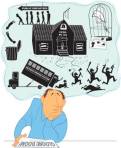
[2] http://www.ctvbc.ctv.ca/servlet/an/local/CTVNews/20100331/bc_april_fee_increases_100331?hub=BritishColumbia
[3] http://edmonton.ctv.ca/servlet/an/local/CTVNews/20100331/bc_april_fee_increases_100331?hub=EdmontonHome
[8] http://www.wsws.org/articles/2007/jun2007/cana-j20.shtml
* By this i mean 15% of $100k = $18k while 15% of roughly the median income, $50k = $7.5k. So, the tax applies the same but the benefit is very unequal.
